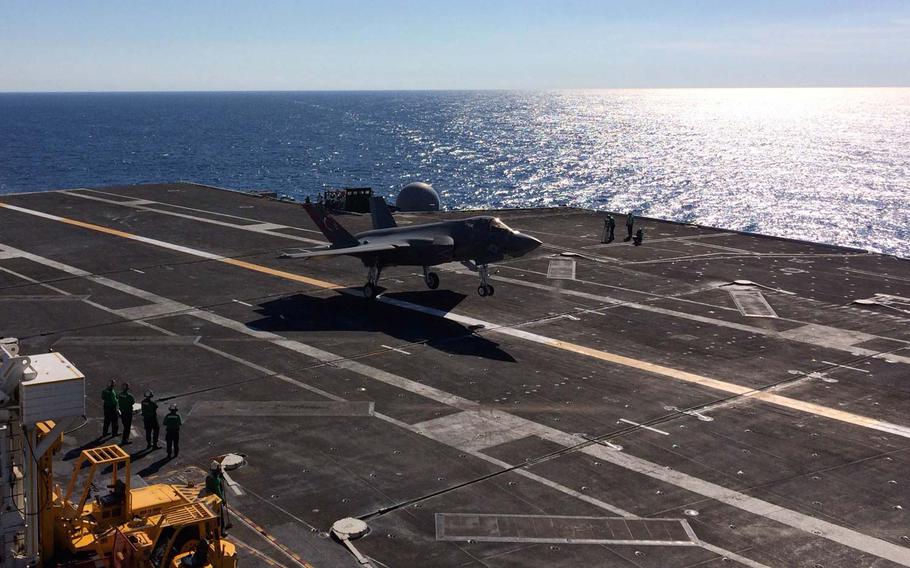
An F-35C makes the aircraft's 1st arrested carrier landing, aboard the USS Nimitz, on Monday, Nov. 3, 2014, near San Diego. (Jennifer Hlad/Stars and Stripes)
ABOARD THE USS NIMITZ — Two F-35Cs landed on the USS Nimitz on Monday, a historic day for the Navy’s oldest aircraft carrier and its newest aircraft.
The Navy’s version of the Joint Strike Fighter, designed for landing on carriers, had undergone extensive testing on land but had never landed on a carrier at sea.
The jets were not the first Joint Strike Fighters to land on a ship at sea. The Marine Corps’ version, the F-35B, first landed on the amphibious assualt ship the USS Wasp during testing in 2011. Monday was the first time the F-35C, the version designed for an aircraft carrier, landed on a carrier.
While the Marines expect to declare initial operational capability for their first squadron of F-35Bs next summer, and the Air Force expects initial operational capability for the F-35A at the end of 2016, the Navy’s F-35Cs — the most expensive of the three variants — was delayed because of problems with the tailhook.
But the tailhook, which was completely redesigned by Lockheed Martin, did not seem to cause any trouble Monday; both jets hooked the third of four wires on the Nimitz’s deck, which is considered ideal.
Senior Chief Petty Officer Alistair McIntyre, the senior maintainer for the aircraft, said there were “no problems, no issues.”
“It looked like both pilots were old pros,” he said.
Cmdr. Tony “Brick” Wilson, the test pilot who was first to land on the Nimitz, said the jet “flew magnificently” and that he couldn’t have taken it out of the glide slope if he tried.
“It is very, very easy to fly,” Wilson said.
Lt. Cmdr. Ted “Dutch” Dyckman, who landed the second F-35C, said he had expected more air disturbance.
“It was just smooth and easy,” he said.
Cmdr. Christian “Wilson” Sewell, another test pilot with the F-35 program, said the aircraft is “much easier to actually fly” than any version of the F/A-18, which will allow pilots to focus on mission and tactics.
“It’s a very stable aircraft,” he said, adding that the computer does much of the work, making it “very easy to fly in general.”
But in addition to the apparent ease of flying, the aircraft will give the Navy stealth capabilities it doesn’t currently have, as well as increased range and next-generation technology, Navy officials said.
“This has been, I think, a long journey,” said Rear Adm. Dee Mewbourne, commander of Carrier Strike Group 11. “I’m excited for what this day means to us. I’m eager to get this new toy … out into the fleet.”
The sense of excitement aboard the ship was palpable. Some members of the flight crew cheered at the loudspeaker announcement that the first plane would be coming in for a low pass, before the first landing.
“This is what we live for,” McIntyre said.
Vice Adm. David Buss, commander of naval air forces, started the morning by telling sailors it was a “history-making day for the Navy and naval aviation.”
Afterward, Buss said he was struck by how stable and steady the planes looked on their approach, and said he is anxious to see the F-35Cs operational.
Each F-35C costs $129 million, a program official said, but the price is expected to drop to $107 million after the initial operating capability is reached in 2018.
Monday was the first day of a two-week initial testing phase aboard the Nimitz; two more testing phases will follow during the next two years. Navy officials had also planned catapault takeoffs for the planes Monday, but those were delayed because of a data issue.
hlad.jennifer@stripes.com Twitter: @jhlad